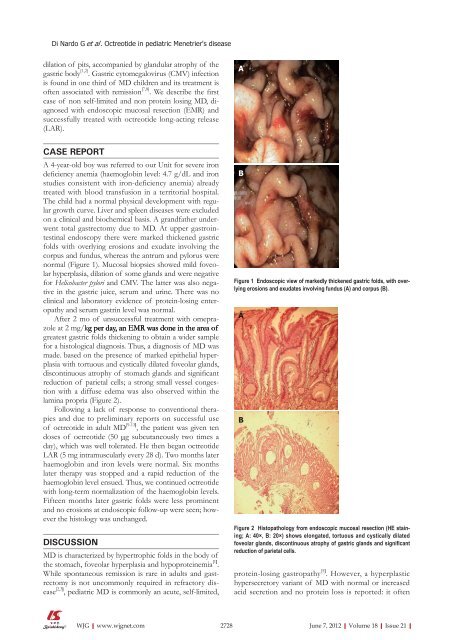Evidence base and patients' perspective - World Journal of ...
Evidence base and patients' perspective - World Journal of ...
Evidence base and patients' perspective - World Journal of ...
You also want an ePaper? Increase the reach of your titles
YUMPU automatically turns print PDFs into web optimized ePapers that Google loves.
Di Nardo G et al . Octreotide in pediatric Menetrier's disease<br />
dilation <strong>of</strong> pits, accompanied by gl<strong>and</strong>ular atrophy <strong>of</strong> the<br />
gastric body [1,2] . Gastric cytomegalovirus (CMV) infection<br />
is found in one third <strong>of</strong> MD children <strong>and</strong> its treatment is<br />
<strong>of</strong>ten associated with remission [7,8] . We describe the first<br />
case <strong>of</strong> non self-limited <strong>and</strong> non protein losing MD, diagnosed<br />
with endoscopic mucosal resection (EMR) <strong>and</strong><br />
successfully treated with octreotide long-acting release<br />
(LAR).<br />
CASE REPORT<br />
A 4-year-old boy was referred to our Unit for severe iron<br />
deficiency anemia (haemoglobin level: 4.7 g/dL <strong>and</strong> iron<br />
studies consistent with iron-deficiency anemia) already<br />
treated with blood transfusion in a territorial hospital.<br />
The child had a normal physical development with regular<br />
growth curve. Liver <strong>and</strong> spleen diseases were excluded<br />
on a clinical <strong>and</strong> biochemical basis. A gr<strong>and</strong>father underwent<br />
total gastrectomy due to MD. At upper gastrointestinal<br />
endoscopy there were marked thickened gastric<br />
folds with overlying erosions <strong>and</strong> exudate involving the<br />
corpus <strong>and</strong> fundus, whereas the antrum <strong>and</strong> pylorus were<br />
normal (Figure 1). Mucosal biopsies showed mild foveolar<br />
hyperplasia, dilation <strong>of</strong> some gl<strong>and</strong>s <strong>and</strong> were negative<br />
for Helicobacter pylori <strong>and</strong> CMV. The latter was also negative<br />
in the gastric juice, serum <strong>and</strong> urine. There was no<br />
clinical <strong>and</strong> laboratory evidence <strong>of</strong> protein-losing enteropathy<br />
<strong>and</strong> serum gastrin level was normal.<br />
After 2 mo <strong>of</strong> unsuccessful treatment with omepra-<br />
zole at 2 mg/�g kg g per �er day, day�� an EMR ���� was �as done in the area <strong>of</strong><br />
o��<br />
greatest gastric folds thickening to obtain a wider sample<br />
for a histological diagnosis. Thus, a diagnosis <strong>of</strong> MD was<br />
made. <strong>base</strong>d on the presence <strong>of</strong> marked epithelial hyperplasia<br />
with tortuous <strong>and</strong> cystically dilated foveolar gl<strong>and</strong>s,<br />
discontinuous atro�hy o�� stomach gl<strong>and</strong>s <strong>and</strong> significant<br />
reduction <strong>of</strong> parietal cells; a strong small vessel congestion<br />
with a diffuse edema was also observed within the<br />
lamina propria (Figure 2).<br />
Following a lack <strong>of</strong> response to conventional therapies<br />
<strong>and</strong> due to preliminary reports on successful use<br />
<strong>of</strong> octreotide in adult MD [9-13] , the patient was given ten<br />
doses <strong>of</strong> octreotide (50 µg subcutaneously two times a<br />
day), which was well tolerated. He then began octreotide<br />
LAR (5 mg intramuscularly every 28 d). Two months later<br />
haemoglobin <strong>and</strong> iron levels were normal. Six months<br />
later therapy was stopped <strong>and</strong> a rapid reduction <strong>of</strong> the<br />
haemoglobin level ensued. Thus, we continued octreotide<br />
with long-term normalization <strong>of</strong> the haemoglobin levels.<br />
Fifteen months later gastric folds were less prominent<br />
<strong>and</strong> no erosions at endoscopic follow-up were seen; however<br />
the histology was unchanged.<br />
DISCUSSION<br />
MD is characterized by hypertrophic folds in the body <strong>of</strong><br />
the stomach, foveolar hyperplasia <strong>and</strong> hypoproteinemia [1] .<br />
While spontaneous remission is rare in adults <strong>and</strong> gastrectomy<br />
is not uncommonly required in refractory disease<br />
[2,3] , pediatric MD is commonly an acute, self-limited,<br />
WJG|www.wjgnet.com<br />
A<br />
B<br />
Figure 1 Endoscopic view <strong>of</strong> markedly thickened gastric folds, with overlying<br />
erosions <strong>and</strong> exudates involving fundus (A) <strong>and</strong> corpus (B).<br />
A<br />
B<br />
Figure 2 Histopathology from endoscopic mucosal resection (HE staining;<br />
A: 40×, B: 20×) shows elongated, tortuous <strong>and</strong> cystically dilated<br />
foveolar gl<strong>and</strong>s, discontinuous atrophy <strong>of</strong> gastric gl<strong>and</strong>s <strong>and</strong> significant<br />
reduction <strong>of</strong> parietal cells.<br />
protein-losing gastropathy [5] . However, a hyperplastic<br />
hypersecretory variant <strong>of</strong> MD with normal or increased<br />
acid secretion <strong>and</strong> no �rotein loss is re�orted: it o��ten<br />
2728 June 7, 2012|Volume 18|Issue 21|

















